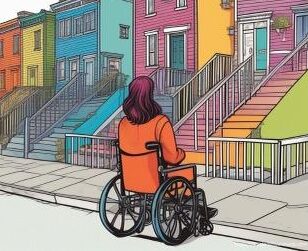- When are businesses that are operated in private homes required to comply with the ADA?
- Businesses that operate in private homes must comply with the ADA if they are places of public accommodation – meaning that they offer goods and services to the public.
- Our ADA Expert, Marsha Mazz, breaks it down for us.
A caller asked if a hair salon in a private home had to be accessible. She made an appointment only to find that the house was completely inaccessible – she couldn’t even get in the door. “What”, she asked, “is up with that”?
Businesses that operate in private homes must comply with the ADA if they are places of public accommodation – meaning that they offer goods and services to the public. They must meet the Department of Justice (DOJ) ADA Title III definition of a “place of public accommodation”. The definition contains an exhaustive list of twelve categories of public accommodations, but nearly every business that serves the public is included in this list in some way.
Very few homes are constructed to include a business so they are not considered places of public accommodation.
Live/work units are the exception: they have special features that allow a business occupancy to be combined with a dwelling unit in one structure, typically a townhouse or similar multi-story unit. Under most state and local building codes, the work portion of the unit must be fully accessible, including a bathroom if it serves the business. The residential portion of the unit is not required to meet the ADA Standards.
Regardless of whether the residence is a live/work unit or not, if the building inspector knows that the unit will include a business, chances are that the areas of the home that are for business use must be accessible.
Most new homes are constructed without the foreknowledge that the owner will want to open a business in the house. So, the eventual owner of the home cannot rely on the building code to require the necessary accessibility. Sometimes the owner must obtain a permit to legally operate the business. Depending on the local code requirements, the owner may have to make certain alterations to the home prior to opening the business, including changes to make the business more accessible.
However, when a homeowner opens a business in their home and alterations are not required, the barriers to access remain in place. This is where the ADA may come to the rescue. The business owner/homeowner is responsible for removing barriers to the extent that doing so is “readily achievable”. To be honest, such businesses are often very small with limited resources, and their barrier removal obligations under the ADA are limited to match their resources.
Examining accessibility requirements of model homes
Homebuilders often use one or more of the homes they have for sale as “model homes”. Because members of the public are invited in to inspect the home, one would think this would make the model home a “place of public accommodation” and it would be required to be accessible. However, model homes are not listed in the twelve categories of “places of public accommodation” defined in the DOJ ADA regulations. Therefore, they are not required to be accessible at all under the ADA unless they contain a place of public accommodation.
An example would be when a model home is also used as a sales office. Then, the portion of the home used in this way must be accessible. If customers are allowed to use the bathroom, this space serving the business must also be accessible in accordance with the ADA Standards. It is not okay to allow only those customers without disabilities to use the restroom. Because the model home will eventually be sold as a residence, some homebuilders with permission from the code official, will not allow anyone to use the restroom. In some cases, they will provide a portable toilet on site. If they do this, the portable toilet must be fully accessible to avoid discrimination based on disability.
If the model home is part of a structure containing four or more multi-family units, it may be subject to the Fair Housing Act. In such cases, it must comply with the Act’s design and construction requirements. At a minimum, the entrance must be accessible and the rest of the unit will have some limited access intended to facilitate adaptations made by the occupant after purchase or rental.


